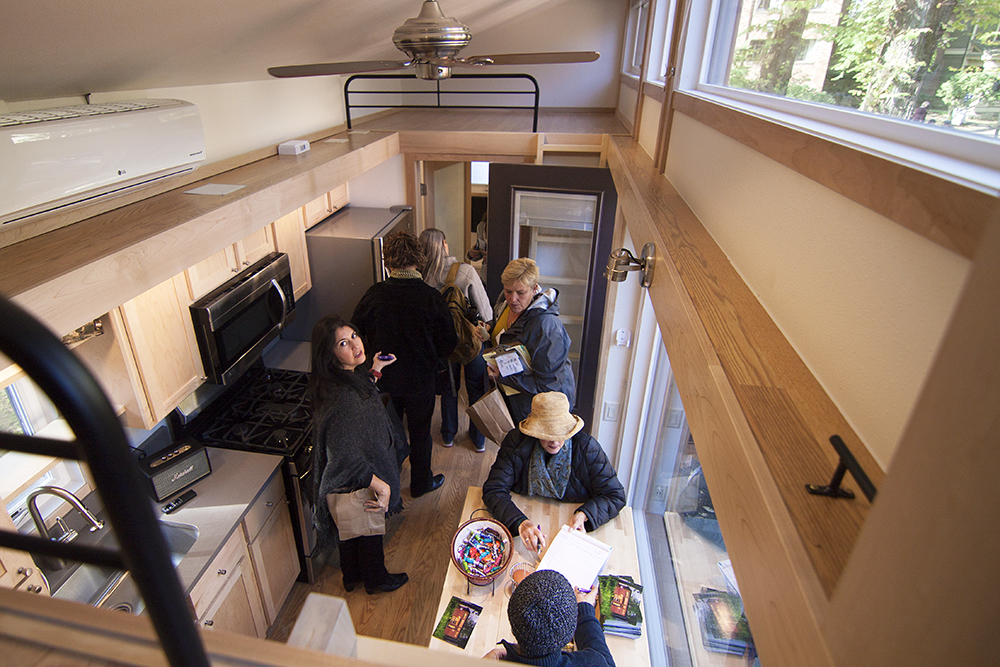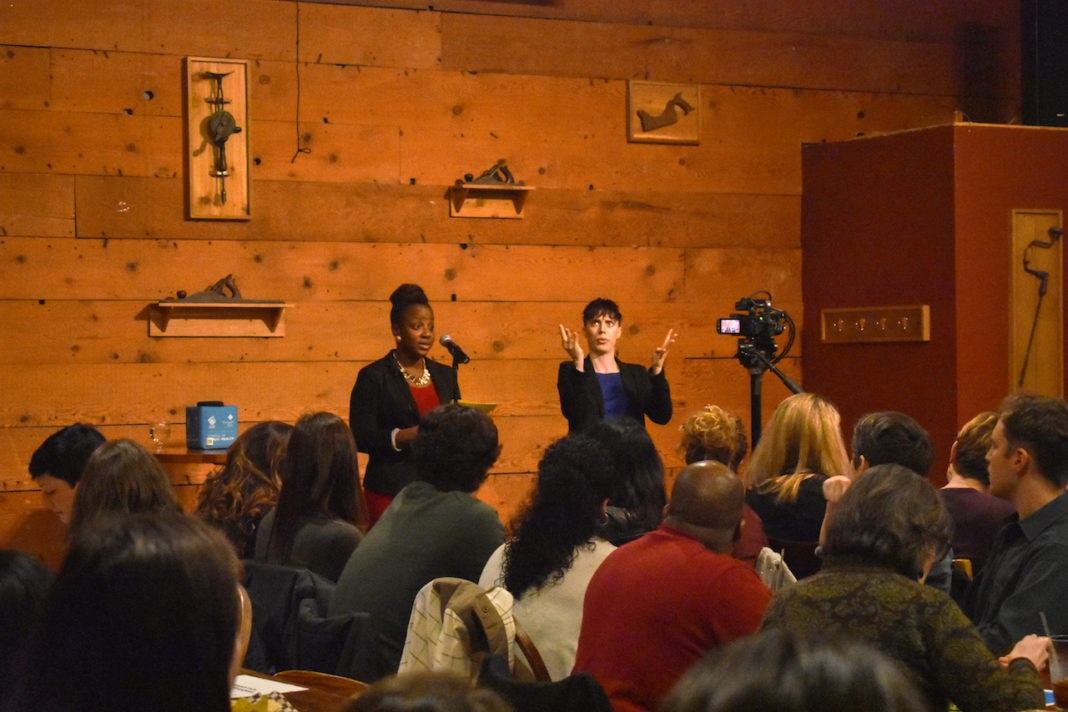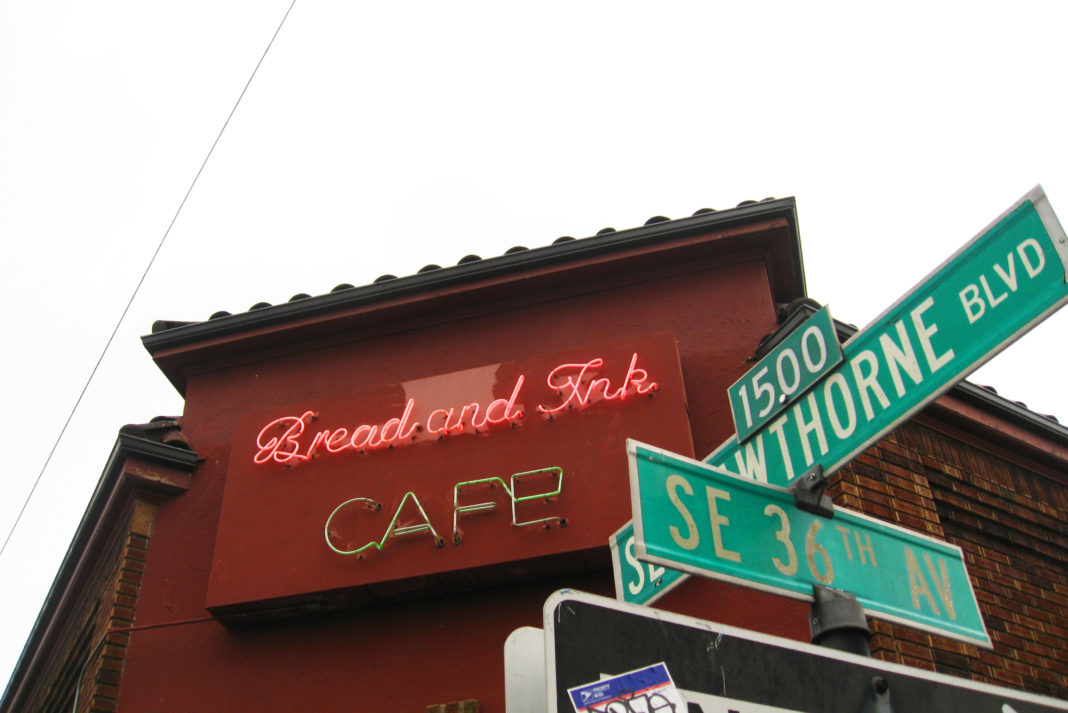Tiny, single-floor houses stood in the south Park Blocks during Build Small Live Large, an educational summit sharing details about small living spaces and their advantages to homeowners and the environment.
Mayor Charlie Hales gave a short speech on Portland’s innovation in green culture and progressive lawmaking at the beginning of the event’s Best of Small Design Slam, a presentation series in which designers showcased their best work.
Keynote speakers included Alan During of the Sightline Institute and Dee Williams of Portland Alternative Dwellings. Panelists spoke throughout Smith Memorial Student Union from 8 a.m. until 7 p.m. on Nov. 6th on topics including affordable housing for the homeless, housing regulations and cluster communities of small homes.
Shawn Wood, a construction-waste specialist at Portland’s Bureau of Planning and Sustainability, was one of the planners of the first Build Small Live Large conference and was asked to help organize 2015’s event.
The summit provides a common space for designers, policymakers and enthusiasts of tiny houses, according to Wood. He hopes that attendees take away from the event the environmental benefits and flexibility of small houses.
“Building small turns out to be one of the best green-building techniques that you can do,” Wood said.
Two of the main topics that speakers addressed at the event were regional policy and advocacy for small-housing construction and discussion of design challenges of compact homes, according to Wood.
“I forget what the registration was at our last summit, but it was around 350 people and today we sold out at 500, so it was a successful event and we look forward to having another one in the future,” Wood said.
Alan DeLaTorre, a research associate at PSU’s Institute on Aging, was a featured speaker at “Beyond Peter Pan Housing: Emerging Trends in the Region,” one of the summit’s concurrent sessions intended to discuss different facets of compact housing.
DeLaTorre’s talk focused on providing accessible housing spaces for aging populations.
“I was able to share with folks–well, in my research, I found that there’s really this missing component of housing for older adults that’s between about 8 units and 12 units,” DeLaTorre said.
Beyond issues of affordability, a deficit of building regulations on smaller homes like duplexes and town houses contributes to the lack of homes accessible to older adults, he said.
“I’ll be honest, there’s lobbies–large groups who are not interested in seeing new laws enacted because it cuts into profit,” DeLaTorre said.
There are not many organizations that bring discussion of aging into conversations about sustainability, according to DeLaTorre.
“This is the second time that I’ve been involved in the conference,” DeLaTorre said. “And both times, they have invited me to speak with an interest in understanding how aging overlaps with building smaller houses, reducing the [carbon footprint] that we have on the environment.”
During the presentation, DeLaTorre was joined by Charles Rynerson, a research faculty member at PSU’s Population Research Center.
Rynerson’s segment during the talk emphasized changes in household composition over the past decade.
“There’s been a big shift over the past fifty years from pretty large households to a majority of smaller households,” Rynerson said.
Some of the principle factors driving this change include aging and lower fertility rates, according to Rynerson. Portland has population trends that are divergent from much of the rest of the nation, he added.
“In particular, the type of place that we are–we’ve attracted a lot of young people–we also have a big bulge in that older baby-boom population because we were also a very attractive region in the 1970s, when people who are now approaching age 65 were young,” Rynerson said.
Due to challenges like financing, construction of small houses on a large scale is generally uncommon for developers, according to him.
“The small-house movement is kind of more of a grassroots thing, and it has gotten a lot of attention here in Portland. And I think this conference is bringing more attention to it,” Rynerson said.







I dunno many old people – even young people – seem to be trapped in their box. Tiny homes are great for many, but I see some things they do not address;
1) People are still separated by walls. Let’s face it; privacy is not an essential NEED and partition walls are a habit/ psychological dependency, the symptoms of which (anhedonia and dysphoria) are everywhere in this society we’ve literally constructed. These walls make it such that people will need to meet some prerequisite expectation (social or financial) as an excuse to find connection/ escape the house. This promotes alienation and the over consumption of non-essentials- something which is prevalent in our society.
Walls also stop people from sharing resources. Think about this one; you do not show up to work to ask someone if they want your size 10 old sneakers or food that you’re not going to use. Neither do many want to take the time to go to Good Will nor do they believe in someone profiting off of what they wanted to share with others for free. Lastly not being in open proximity/ visibility to one another kills the incentive to share with one another and makes it such that the will to share resources needs to be consciously maintained rather than occurring intrinsically.
Overproduction/ consumption of non-essential + lack of human contact + lack of sharing = rich profit off of lower classes lack of sharing + 200 ft. tall landfills + lack of trust for/ camaraderie with “neighbors” who never share anything with us.
2) Tiny homes are not profitable, therefore how can they have leverage against developers who will inevitably displace them when it suits them? How can they COMPETE in this environment? And if they cannot compete in a capitalist market, how exactly is it that they are truly sustainable?
3) Tiny homes will not drop rental prices for surrounding areas. Tiny homes on 92nd and division are listed for ~$450 – $500 in what is a far from central location and an undesirable neighborhood for many.
… Like I said, they work for many and are a good option to have on the table, but why is it you urban planners never question the very walls separating people? You cannot solve the problems you attempt to solve by doing the same thing every other town tried and failed at, which is giving everyone their own privacy and selling them the american dream of property ownership at a smaller and lesser scale.
Pack a warehouse full of beds and rent them. Encapsulate the beds by throwing plywood or some other material (get creative) around them if you’re so addicted to barriers, but there is absolutely no reason people need to hide behind walls at all hours of the day.
LOL!!
Physicists: 1
Urban Planners: 0
I want walls. Sorry.
keep em’. But not having something like this as an option for those who need it means your going to (and you do) pay for many homeless peoples housing and subsidizing many more people’s rent. Furthermore when development occurs rental prices get pulled up from one end but never down from the other because there is nothing on the market that can do so- tiny homes included. All the while you’ll still be complaining about hobo’s being in front of your business when the state could be making money (that you could use to fix your road?) off the problem, clearing them hobo’s away from your business, and putting something on the market that actually restores your leverage and drops your rental prices (even if you never have anything to do with it) in the process. People in between jobs, transplants, and broke students would all find use in such a place for some amount of time or another (however short or long) and save hundreds every month.
It is an ironic and sadly standard response for folks to assume I am talking about them- I am just talking about putting options on the table for those who need them. The reality is you live in an INTERDEPENDANT society and every once in a while the solutions to your problems may not lie in always thinking of your own little box.
Certainly a home is good if and when you have one and it is good to you, but too much of anything is not a good thing- even if it is your thing. What we’re doing has not worked for many and “gentrification” will play out the same if we do what everyone else did. Do you really think a 10×12 tiny home is that different from a 10×12 SRO? These walls cost $$$$; journey man electricians, drywallers, plumbers, door and cabinet companies are not cheap. Furthermore you only have one or two people paying rent fer x amount of square feet meaning the rents will need to be increased, subsidized, or the places will rot- they are called halfway houses.
Keep your walls no one threatened to take them- what was the point of that comment?
Jeff is the Market and the Market has spoken!